Introduction: Our next book is Zoom, Zoom, Baby by Karen Katz. In this book there are many environmental sounds, sounds we hear around us. We can say these sounds together. Let's practice first (children and adults say each sound together, adding repetitions till they are comfortable with saying the sounds--the boat goes putt-putt; the bus goes beep! beep, the plane goes whoosh-whoosh, the train goes choo-choo; the truck goes rumble-rumble; and the car goes zoom-zoom.
OK! let's read this book all together.
Early Literacy Aside--Example: Adults, drawing your children's attention to the sounds in the environment helps them become aware of sounds. This is a very beginning step to having them later hear the smaller sounds in words which will later help them sound out words when they learn to read. (That skill is called phonological awareness.)
Early Literacy Aside--Empower: Adults, remember the book Zoom, Zoom, Baby by Karen Katz, which I read earlier? You can talk about the sounds you hear at home and as you go about your errands, even without a book. Helping your children become more aware of sounds will help them later hear those smaller sounds in words which will help them sound out words as they learn to read. Yes! It does start early.
















